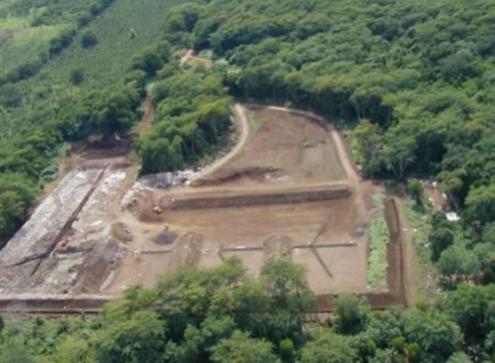10.2.5 Sanitary landfill
A sanitary landfill is an engineered facility for the disposal of waste from larger towns and cities (Figure 10.3). To be cost-effective there needs to be more than around 150 metric tons of waste deposited in a day. The site is designed and operated to minimise public health and environmental impacts. The additional environmental control measures should include a system to collect and treat leachate, better gas venting systems and good amenities for site staff. In Figure 10.3 you can see the drainage channels for leachate that have been prepared before the waste is added to the area in the foreground. Larger sites should be divided into ‘cells’ separated by earth banks. Adding waste to one cell at a time allows each part of the site to be filled and covered more quickly.

For the largest cities, the ideal sanitary landfill would also have:
- an active system to pump out landfill gas and burn it, ideally making use of the heat generated
- a liner made of compacted clay or a synthetic membrane sheet that separates the waste from the ground below and prevents leachate leaking from the site and into the surrounding ground.
These types of landfill sites are uncommon in African countries, but efforts are being made to convert the Repi landfill in Addis Ababa into a sanitary landfill.
According to the data in Study Session 7, typical waste generation rates in Ethiopia are between 0.3 kg and 0.5 kg per person per day. If you assume a rate of 0.3 kg, how big a population would a city need for it to operate a sanitary landfill?
To be cost-effective, a sanitary landfill needs to take at least 150 metric tons of waste a day, which is 150,000 kg. If all this waste came from residential sources, this would need:
people
10.2.4 Controlled landfill
